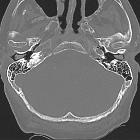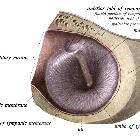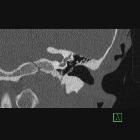Trommelfell








The tympanic membrane is a thin membrane that separates the external ear from the middle ear. It acts to transmit sound waves from air in the external auditory canal (EAC) to the ossicles of the middle ear.
Gross anatomy
The tympanic membrane is shaped like a flat cone pointing into the middle and inner ear. At the center of the concavity the deepest point is called the umbo.
It attaches to an incomplete ring of bone along the wall of the EAC, the tympanic annulus. It consists of three layers (from external to internal):
There are two distinct portions of the membrane:
- pars tensa: the tense portion of the membrane is the larger portion and extends from the anterior and posterior malleolar folds at the level of the lateral process of the malleus to the inferior edge of the membrane
- pars flaccida: the flaccid portion of the membrane is much smaller and is the portion of the membrane above the anterior and posterior malleolar folds
Quadrant separation
It is anatomically separated into four quadrants:
- anterosuperior
- anteroinferior
- posteroinferior
- posterosuperior
This is important because vessels and nerves (specifically chorda tympani nerve) pass through the superior portion of the membrane. Additionally, the light reflex (cone of light) is specific to the anteroinferior portion of the membrane. Thus, when intervention is performed, the posteroinferior portion of the membrane is chosen.
Innervation
The membrane has two distinct nerve supplies based on the different embryological origins of the internal and external surfaces.
- external surface
- predominantly the auriculotemporal nerve (CN V3)
- greater auricular nerve (C2, C3)
- some authors report some minor contribution from the auricular branch (Arnold's nerve) of the vagus nerve (CN X)
- internal surface: tympanic branch of the glossopharyngeal nerve (CN IX)
Arterial Supply
- external surface
- deep auricular artery (branch of maxillary artery)
- internal surface
- anterior tympanic artery (branch of maxillary artery)
- stylomastoid branch of posterior auricular artery (branch of external carotid artery)
Related pathology
- conductive hearing loss: secondary to rupture or perforation
- tympanic membrane retraction
- tympanic membrane bulging
- myringosclerosis
See also
Siehe auch:
- Cavum tympani
- Malleus
- Ossikel
- pars flaccida
- pars tensa
- Meatus acusticus externus
- tympanic membrane retraction
- Prussak-Raum
- Recessus membranae tympani anterior
- Recessus membranae tympani posterior
- external ear
- Myringosklerose
und weiter:

 Assoziationen und Differentialdiagnosen zu Trommelfell:
Assoziationen und Differentialdiagnosen zu Trommelfell:


